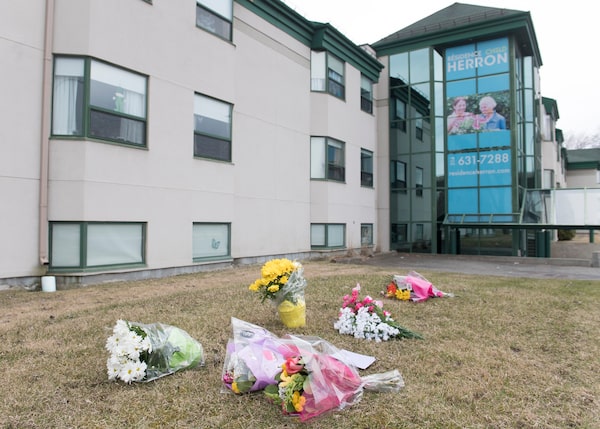
Flowers sit outside Maison Herron, a long-term care home in the Montreal suburb of Dorval on April 12, 2020.Graham Hughes/The Canadian Press
Until COVID-19 turned many of the country’s long-term care homes into deadly prisons for their vulnerable residents, you would have been hard-pressed to argue that Canada treats its seniors poorly. Yet that is the conclusion many people seem to be making these days as the coronavirus pandemic casts a ghastly light on the living and working conditions inside some care homes.
The truth is that, overall, the current generation of Canadian seniors enjoys a better quality of life than any that came before it. Canadians are living longer and healthier lives, and most seniors are more financially comfortable than ever. Public and private pension programs created since the 1960s have vastly reduced the poverty rate among Canadian seniors to one of the lowest in the world.
In 2018, about 3.5 per cent of Canadians aged 65 or over lived below the official poverty line, compared to 8.7 per cent for the Canadian population overall, according to Statistics Canada. Many seniors do still struggle to make ends meet. But Canada’s social safety net has ensured that the proportion of seniors living in poverty has declined dramatically from one generation to the next.
April 16: Join André Picard for a live Q&A
Coronavirus guide: Updates and essential resources about the COVID-19 pandemic
“Elderly benefits,” as they’re called by the government, are the single largest expense in the federal budget, totaling $53.3-billion in the 2019-2020 fiscal year that ended on Mar. 31. Ottawa’s own projections show the cost of Old Age Security and the Guaranteed Income Supplement rising to $70-billion by 2023.
Much of the $264-billion Canada spends annually on health care is devoted to caring for seniors. Per-capita health spending for Canadians aged 15 to 64 stood at $3,052 in 2019, compared to $11,483 for those 65 and older. For those 80 and over, the cost was about $21,000, according to data from the Canadian Institute for Health Information.
The sums spent on pensions and health care for seniors reflect, in part, the gratitude Canadians feel toward those whose hard work in the past helped make this country great. With ever more baby boomers entering their twilight years, however, the number of Canadian seniors requiring 24-hour care has been growing rapidly. At the same time, a slow-growing working-age population has made it harder to staff long-term care homes, where the pay is scandalously low.
For years, the Canadian Medical Association has been pressing Ottawa to develop a national seniors health-care strategy to prepare the country for the coming tsunami in long-term care. But under Conservative Prime Minister Stephen Harper, Ottawa did not do national health-care strategies – period – while Liberal Prime Minister Justin Trudeau has focused on other priorities.
“Unlike some of our predecessors in Ottawa, who often tried to impose rigid bureaucratic health-care conformity on the provinces, we have respected their constitutional jurisdiction over health care and encouraged their innovations,” Rona Ambrose, who served as Mr. Harper’s third and final health minister, said in a 2014 speech.
The consequences of Ottawa’s unwillingness to coordinate a national strategy on long-term care were bound to show up sooner or later. When it comes to public funding, long-term care homes have long been the poor cousin to acute-care hospitals. Yet as provinces moved to cut hospital beds in recent years, the demand for long-term care has exploded. Every province has long waiting lists for spots in their facilities.
There is no mystery as to why COVID-19 has struck publicly-funded long-term care homes with such a vengeance. Their residents almost universally have underlying health conditions that complicate coronavirus infections. More than 60 per cent of them suffer from Alzheimer’s disease or other forms of dementia, according to the Canadian Association for Long Term Care.
Residents live in cramped quarters, sometimes four to a room. In Quebec, health authorities unwittingly contributed to the propagation of the coronavirus by transferring seniors from hospitals to long-term care facilities, ironically to free up hospital beds for COVID-19 patients. And until very recently, caregivers who worked at multiple facilities helped transmit the virus from one place to another.
Unfortunately, it has taken the tragedies now striking long-term care homes in Canada to focus attention on a problem that has been long in the making. To avoid such tragedies from recurring in the future, a national long-term care strategy is needed to fund modern (pandemic-ready) infrastructure and to provide caregiver training and salaries commensurate with the job.
As a country, we need to rethink how we approach long-term care from top to bottom. And we don’t have a lot of time to do it. A 2017 Conference Board study estimated that, to meet demand, Canada needs to nearly double the number of long-term care beds available to about 450,000 by 2035.
We can’t afford to do it on the cheap.
Sign up for the Coronavirus Update newsletter to read the day’s essential coronavirus news, features and explainers written by Globe reporters and editors.
 Konrad Yakabuski
Konrad Yakabuski